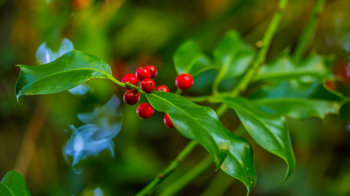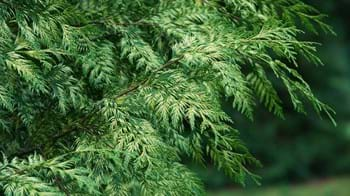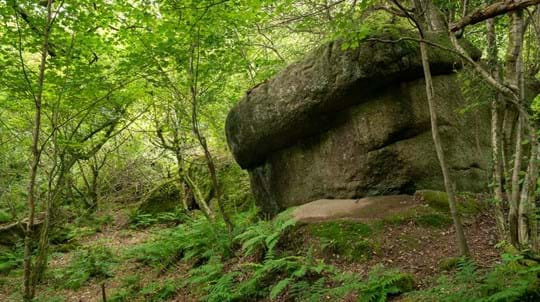
Shaptor Woods
Bovey Tracey

Woodland Trust wood group
- Shaptor Woods
- Furzeleigh Plantation
70.25 ha (173.59 acres)
SX811805
Explorer 110
OS Landranger 191
Shaptor Woods shelters pockets of boulder-strewn ancient woodland, filled with gnarled trees festooned in mosses and lichens. In spring the woodland floor reveals its history with a profusion of bluebells, orchids and ferns. And the high point at Shaptor Rocks offers stunning views over Bovey Tracey and the surrounding countryside.
Shaptor was of the first 20 woods brought into the care of the Woodland Trust in the 1970s by Trust founder Kenneth Watkins, thanks to a grant from the Countryside Commission. Today it remains a well-beloved piece of Dartmoor's most precious woodland.
Features
- Parking at site
- Autumn colour
- Spring flowers
- Waymarked walk
- Moorland
- Broadleaved woodland
How to get to Shaptor Woods
Shaptor Woods is less than 2km from the town of Bovey Tracey, on the eastern side of the Wray Valley in Dartmoor.
The wood is less than 2km north of Bovey Tracey. Access up to the woods is via small, steep country lanes that have no provision for pedestrians.
The nearest train station is in Newton Abbot, approximately 8 miles away.
For the latest information on public transport visit traveline.info.
The nearest bus stop is in Union Square, Fore Street, Bovey Tracey, approximately 1.5 miles from Furzeleigh Cross. There are regular buses to Bovey from Exeter.
For the latest information on public transport visit traveline.info.
Facilities and access
There are several pedestrian access points into Shaptor Woods. A public footpath runs across the northern end of the wood, starting just above the area known as Northcombe Copse. This runs east directly below Shaptor Rocks. Both access points have step-over stiles.
A permissive path links to the public footpath and traverses south through the whole length to join with the public bridleway known as Little John's Walk. Two gated entrances provide access. This permissive path provides an unmodified surface which in places winds through large outcrops of granite, over old historic drystone field walls and up and down steep slopes.
Little John's Walk divides Shaptor Woods from Furzeleigh Plantation, another Woodland Trust property.
As Shaptor Woods is a remote site, public access is largely informal and relatively challenging due to the uneven and winding nature of the paths.
Parking for three or four cars is possible at Furzeleigh Cross, grid reference SX819797.
Bovey Tracey is the nearest town (approximately 2 miles away) with facilities for visitors. Toilets can be found in the Station Road Car Park, including a disabled toilet (RADAR keys required).
Wildlife and habitats
Animals
Shaptor Woods is a great place to hear birdsong in spring and to look out for woodland birds such as marsh tit, siskin and redstart, a summer migrant. Butterflies such as ringlet and silver washed fritillary also call the woods home, and both the pearl-bordered and small pearl-bordered fritillary butterflies have been recorded on Shaptor Down. You may even spot the impressive golden-ringed dragonfly - a moorland specialist.
Trees, plants and fungi
The woods support a number of lichens, including some rare species. It is also important for mosses, ferns and woodland floor plants, all of which point to Shaptor's long history as woodland. Look out for yellow archangel, sanicle, woodruff and wood melick among some of the more familiar spring flowers. If you're lucky you may even find the scarce bird's-nest orchid.
Habitats
Shaptor Woods is an upland oak wood, the northern tip of which is remote and mostly undisturbed. It is made up of a number of small ancient woods and copses which, over the years, have been united by younger woodland that has grown up in between. Shaptor Woods is an important example of temperate rainforest habitat on Dartmoor.
Shaptor Down, an area of former moorland that is slowly self-seeding into woodland, also contains open habitat for butterflies, heather and dragonflies.

A lasting legacy
This wood is just one of many to have been protected by gifts in wills, securing it for generations to come. Your legacy gift could also make a real difference to woods, trees and wildlife.
Learn what your gift could meanAbout Shaptor Woods
Mining
Micaceous haematite (an iron oxide ore) was mined here until the last century. A number of adits (horizontal tunnels) and shafts are still present, mostly in the northern part of the wood. The area is known to be important for bats, and it's thought these old shafts could provide vital roosting sites.
History
Shaptor is criss-crossed by a number of ancient field boundaries and old stone walls still visible today. Look for old hedge banks lined with mature and veteran trees, some of which show signs of pollarding. There are also old oak coppice stools hidden throughout the wood.
Things to do at Shaptor Woods
Walks
Some of Shaptor Woods' most prominent features are its granite boulders and small tors which are scattered throughout the wood. The wood's permissive path leads to Shaptor Rocks, a local beauty spot that offers magnificent views across the valley and open moor of the surrounding landscape.











































